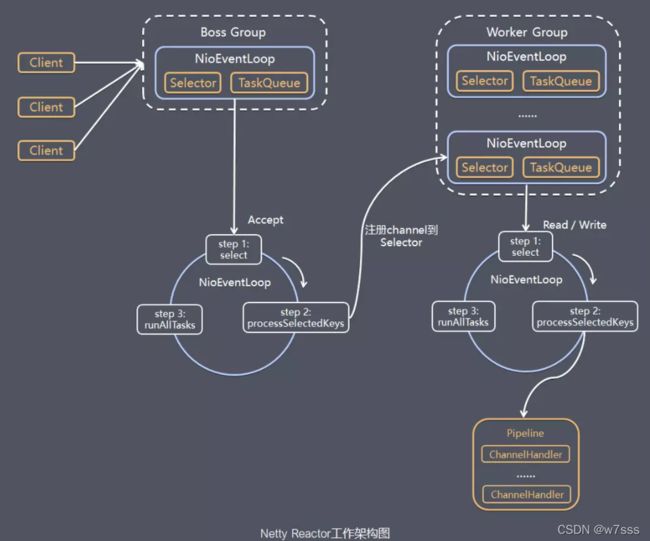Netty源码之EventLoop工作原理
前言
上一篇分析了Netty服务端启动原理,本篇会详细介绍Netty服务启动后的工作流程。
NioEventLoop
Netty线程模型中,NioEventLoop是一个非常重要的类,把netty服务看成是一个工厂,bossGroup中的NioEventLoop负责分配任务,而workerGroup中的NioEventLoop就是干活的工人,也就是处理读写事件。
上篇讲到Netty服务启动后,bossGroup中的NioEventLoop就开始工作,下面就从NioEventLoop的run方法开始分析:
protected void run() {
//loop循环工作主流程
for (;;) {
try {
try {
//选择策略,如果自己的队列中有任务则这直接调用selectNow(),让select马上返
//否则会来到SelectStrategy.SELECT:正常调用select(wakenUp.getAndSet(false))
//这个不难理解,因为如果有队列任务,自然需要去执行,所以直接select后往下走
switch (selectStrategy.calculateStrategy(selectNowSupplier, hasTasks())) {
case SelectStrategy.CONTINUE:
continue;
case SelectStrategy.BUSY_WAIT:
// fall-through to SELECT since the busy-wait is not supported with NIO
//这里又会进入一个select死循环,具体逻辑进去看下
case SelectStrategy.SELECT:
select(wakenUp.getAndSet(false));
if (wakenUp.get()) {
//如果wakenUp为true,则让selector.select直接返回
//这里主要考虑到用户线程可以显示调用wakenUp()方法改变wakenUp的值
//这里的操作主要是想让下一次select循环完成select后直接返回,具体会在select(wakenUp.getAndSet(false))中体现
selector.wakeup();
}
// fall through
default:
}
} catch (IOException e) {
rebuildSelector0();
handleLoopException(e);
continue;
}
cancelledKeys = 0;
needsToSelectAgain = false;
final int ioRatio = this.ioRatio;
//ioRatio 默认为50,表示eventloop执行IO与非IO任务的时间比例大致相等
if (ioRatio == 100) {
try {
processSelectedKeys();
} finally {
// Ensure we always run tasks.
runAllTasks();
}
} else {
final long ioStartTime = System.nanoTime();
try {
//处理socket事件
processSelectedKeys();
} finally {
// Ensure we always run tasks.
final long ioTime = System.nanoTime() - ioStartTime;
//执行等待队列中的任务
runAllTasks(ioTime * (100 - ioRatio) / ioRatio);
}
}
} catch (Throwable t) {
handleLoopException(t);
}
// Always handle shutdown even if the loop processing threw an exception.
try {
if (isShuttingDown()) {
closeAll();
if (confirmShutdown()) {
return;
}
}
} catch (Throwable t) {
handleLoopException(t);
}
}
}首先分析下几个主要方法,先看select(wakenUp.getAndSet(false)),传进去的是wakenUp的旧值,然后把wakenUp改为false,这里在说下,wakenUp这个值,为false意味着,下一次select会阻塞直到超时,为true则会马上返回,而且用户线程有方法可以显示的修改这个值:
private void select(boolean oldWakenUp) throws IOException {
Selector selector = this.selector;
try {
int selectCnt = 0;
long currentTimeNanos = System.nanoTime();
long selectDeadLineNanos = currentTimeNanos + delayNanos(currentTimeNanos);
for (;;) {
//计算一下超时时间,因为enventloop也可以接收延时任务,如果没有延时任务,默认超时时间为0.5毫秒
long timeoutMillis = (selectDeadLineNanos - currentTimeNanos + 500000L) / 1000000L;
//如果超时时间不超过0,则直接selectNow()返回
if (timeoutMillis <= 0) {
if (selectCnt == 0) {
selector.selectNow();
selectCnt = 1;
}
break;
}
//判断有没有队列任务,如果有则selectNow()返回
//如果wakenUp为ture,这里是不会进去的,因为如果wakenUp为ture,下面的selector.select(timeoutMillis)也会直接返回
if (hasTasks() && wakenUp.compareAndSet(false, true)) {
selector.selectNow();
selectCnt = 1;
break;
}
//NIO的select操作,超时则返回
int selectedKeys = selector.select(timeoutMillis);
selectCnt ++;
if (selectedKeys != 0 || oldWakenUp || wakenUp.get() || hasTasks() || hasScheduledTasks()) {
//如果有事件或有队列任务,或者wakenUp新或旧值为true,则返回
break;
}
if (Thread.interrupted()) {
if (logger.isDebugEnabled()) {
logger.debug("Selector.select() returned prematurely because " +
"Thread.currentThread().interrupt() was called. Use " +
"NioEventLoop.shutdownGracefully() to shutdown the NioEventLoop.");
}
selectCnt = 1;
break;
}
long time = System.nanoTime();
if (time - TimeUnit.MILLISECONDS.toNanos(timeoutMillis) >= currentTimeNanos) {
//这里判断一下时间,如果是正常超时的则做相应的操作
//至于为什么有这种莫名其妙的操作,连同下面的else下面会讲到
selectCnt = 1;
} else if (SELECTOR_AUTO_REBUILD_THRESHOLD > 0 &&
selectCnt >= SELECTOR_AUTO_REBUILD_THRESHOLD) {
selector = selectRebuildSelector(selectCnt);
selectCnt = 1;
break;
}
currentTimeNanos = time;
}
if (selectCnt > MIN_PREMATURE_SELECTOR_RETURNS) {
if (logger.isDebugEnabled()) {
logger.debug("Selector.select() returned prematurely {} times in a row for Selector {}.",
selectCnt - 1, selector);
}
}
} catch (CancelledKeyException e) {
if (logger.isDebugEnabled()) {
logger.debug(CancelledKeyException.class.getSimpleName() + " raised by a Selector {} - JDK bug?",
selector, e);
}
}
}上面的selectCnt 这个变量,先是++操作,后面判断又置为1,主要是为了解决java NIO的空轮询bug,这个bug会让select不超时直接返回,在循环中导致cpu占用急剧拉升。netty用selectCnt这个标识判断(通过selectCnt是否大于某个阈值),如果出现了空轮询bug,就重新build一个selector,也就是else中的逻辑,大家感兴趣可点进去看看。
假设现在有一个客户端发起了连接,select正常返回,那么来到processSelectedKeys():
private void processSelectedKeys() {
if (selectedKeys != null) {
processSelectedKeysOptimized();
} else {
processSelectedKeysPlain(selector.selectedKeys());
}
}
private void processSelectedKeysOptimized() {
//遍历selectedKeys
for (int i = 0; i < selectedKeys.size; ++i) {
final SelectionKey k = selectedKeys.keys[i];
selectedKeys.keys[i] = null;
//拿到channel上的attachment,也就是NioServerSocketChannel
final Object a = k.attachment();
if (a instanceof AbstractNioChannel) {
//处理事件
processSelectedKey(k, (AbstractNioChannel) a);
} else {
@SuppressWarnings("unchecked")
NioTask task = (NioTask) a;
processSelectedKey(k, task);
}
if (needsToSelectAgain) {
selectedKeys.reset(i + 1);
selectAgain();
i = -1;
}
}
}
private void processSelectedKey(SelectionKey k, AbstractNioChannel ch) {
final AbstractNioChannel.NioUnsafe unsafe = ch.unsafe();
//一些验证判断,如果不在当前工作线程内会return,考虑到当前channel已经注销
if (!k.isValid()) {
final EventLoop eventLoop;
try {
eventLoop = ch.eventLoop();
} catch (Throwable ignored) {
return;
}
if (eventLoop != this || eventLoop == null) {
return;
}
unsafe.close(unsafe.voidPromise());
return;
}
try {
int readyOps = k.readyOps();
if ((readyOps & SelectionKey.OP_CONNECT) != 0) {
int ops = k.interestOps();
ops &= ~SelectionKey.OP_CONNECT;
k.interestOps(ops);
unsafe.finishConnect();
}
if ((readyOps & SelectionKey.OP_WRITE) != 0) {
ch.unsafe().forceFlush();
}
// to a spin loop
if ((readyOps & (SelectionKey.OP_READ | SelectionKey.OP_ACCEPT)) != 0 || readyOps == 0) {
unsafe.read();
}
} catch (CancelledKeyException ignored) {
unsafe.close(unsafe.voidPromise());
}
} 一个客户端发起连接,所以是accept事件,所以聚焦这个if:
if ((readyOps & (SelectionKey.OP_READ | SelectionKey.OP_ACCEPT)) != 0 || readyOps == 0) {
unsafe.read();
}
用netty自己实现的unsafe处理accept事件,这里是服务端channel的unsafe,会走NioMessageUnsafe这个子类:
public void read() {
assert eventLoop().inEventLoop();
final ChannelConfig config = config();
final ChannelPipeline pipeline = pipeline();
//接收缓冲区分配器
final RecvByteBufAllocator.Handle allocHandle = unsafe().recvBufAllocHandle();
allocHandle.reset(config);
boolean closed = false;
Throwable exception = null;
try {
try {
do {
//读取数据,这里会循环读取
int localRead = doReadMessages(readBuf);
if (localRead == 0) {
break;
}
if (localRead < 0) {
closed = true;
break;
}
allocHandle.incMessagesRead(localRead);
} while (allocHandle.continueReading());
} catch (Throwable t) {
exception = t;
}
int size = readBuf.size();
for (int i = 0; i < size; i ++) {
readPending = false;
//对于每个客户端连接,调用服务端handler的Channelread方法
pipeline.fireChannelRead(readBuf.get(i));
}
readBuf.clear();
allocHandle.readComplete();
//调用服务端handler的ChannelReadComplete方法
pipeline.fireChannelReadComplete();
...
} finally {
if (!readPending && !config.isAutoRead()) {
removeReadOp();
}
}
}接下来看读取数据方法doReadMessages(readBuf):
protected int doReadMessages(List读完数据后来到pipeline.fireChannelRead(readBuf.get(i)),触发服务端handler的ChannelRead方法,看过上一篇的应该知道,服务端的handler就是ServerBootstrapAcceptor,下面直接来到ServerBootstrapAcceptor的ChannelRead,我们知道,这个方法主要就是把客户端的socketChannel注册到workerGroup中某个enventLoop的selector上:
public void channelRead(ChannelHandlerContext ctx, Object msg) {
final Channel child = (Channel) msg;
//把handler加入channel的pipeline,这里的childHandler就是用户自行编写的处理读事件的handler
child.pipeline().addLast(childHandler);
//设置channel参数相关
setChannelOptions(child, childOptions, logger);
for (Entry, Object> e: childAttrs) {
child.attr((AttributeKey 注册channel会来到MultithreadEventLoopGroup#:
public ChannelFuture register(Channel channel) {
return next().register(channel);
}
next方法会轮询选出一个eventLoop处理注册任务,至于注册的逻辑会在eventLoop处理队列任务时执行,注册完后会执行handler生命周期各个方法,和注册服务端NioServerSocketChannel的过程是一样的,这在上篇启动原理已经详细介绍,这里就不细说了。
注册完成后,workerGroup的各个eventLoop会从run方法开始,循环执行IO和非IO任务,这里当然就是客户端读写事件和注册channel事件。
和服务端分派线程不同的是工作线程的读数据逻辑,再次来到
if ((readyOps & (SelectionKey.OP_READ | SelectionKey.OP_ACCEPT)) != 0 || readyOps == 0) {
unsafe.read();
}
工作线程来到这里会进入NioByteUnsafe#read,逻辑和分派线程读数据的差不多,只是这里变成了字节读取:
public final void read() {
//省略...
try {
do {
byteBuf = allocHandle.allocate(allocator);
//将数据读入字节缓冲区byteBuf
allocHandle.lastBytesRead(doReadBytes(byteBuf));
if (allocHandle.lastBytesRead() <= 0) {
byteBuf.release();
byteBuf = null;
close = allocHandle.lastBytesRead() < 0;
if (close) {
readPending = false;
}
break;
}
allocHandle.incMessagesRead(1);
readPending = false;
pipeline.fireChannelRead(byteBuf);
byteBuf = null;
} while (allocHandle.continueReading());
allocHandle.readComplete();
pipeline.fireChannelReadComplete();
if (close) {
closeOnRead(pipeline);
}
} catch (Throwable t) {
handleReadException(pipeline, byteBuf, t, close, allocHandle);
} finally {
if (!readPending && !config.isAutoRead()) {
removeReadOp();
}
}
}最后依然会fireChannelRead调用handler的ChannelRead方法。
遗留了一点,关于每个eventLoop队列任务的执行:
protected boolean runAllTasks(long timeoutNanos) {
fetchFromScheduledTaskQueue();
Runnable task = pollTask();
if (task == null) {
afterRunningAllTasks();
return false;
}
//计算到期时间
final long deadline = ScheduledFutureTask.nanoTime() + timeoutNanos;
long runTasks = 0;
long lastExecutionTime;
for (;;) {
//执行队列任务
safeExecute(task);
runTasks ++;
//每执行64个任务检查下有没有到期
if ((runTasks & 0x3F) == 0) {
lastExecutionTime = ScheduledFutureTask.nanoTime();
if (lastExecutionTime >= deadline) {
//如果给定时间用完了,就退出方法,剩余的任务留到下次执行
break;
}
}
task = pollTask();
if (task == null) {
lastExecutionTime = ScheduledFutureTask.nanoTime();
break;
}
}
afterRunningAllTasks();
this.lastExecutionTime = lastExecutionTime;
return true;
}这个方法的入参是ioTime * (100 - ioRatio) / ioRatio,即处理IO任务的事件乘以一个倍数,这个倍数是非IO任务所能占用的时间和IO任务所能占用的时间的比值,也就是用来表示runAllTasks能占用的时间。
至此,netty的工作流程差不多就结束了。
盗个图总结一下:
其实netty最核心的还是要理解NioEventLoop的工作模型,它是netty中干活的线程,因为是一个线程循环的执行任务,所以叫事件循环线程,上图画的够形象的了。
关于netty,还有很多内容,诸如Pipeline是如何工作的,netty独有的堆外内存管理模型,内存零拷贝,心跳handler等等,后面有机会再讲吧。
